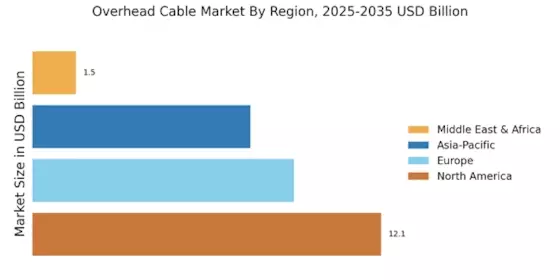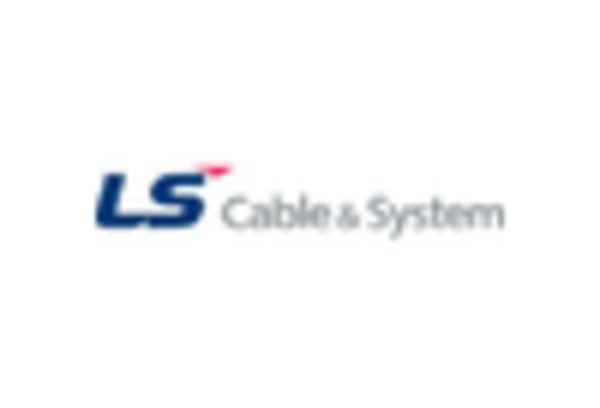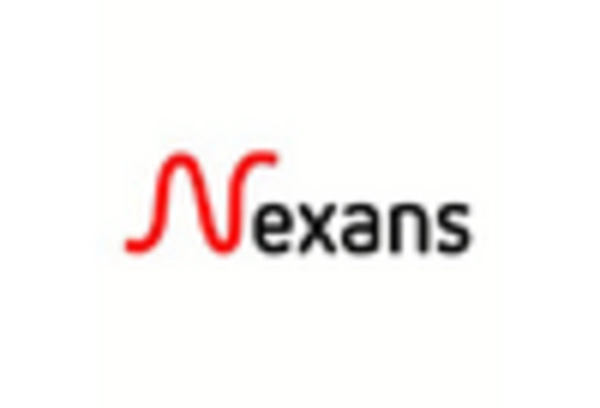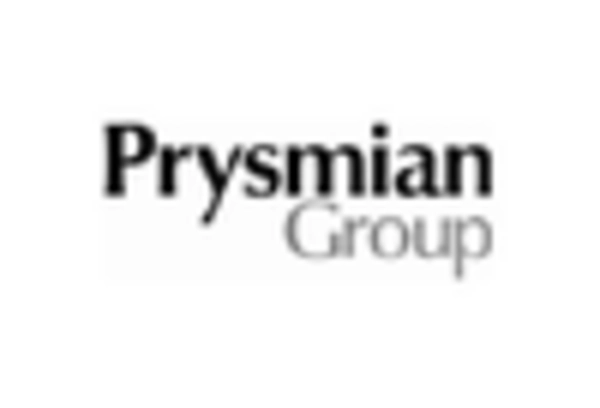Rising Demand for Renewable Energy
The increasing emphasis on renewable energy sources is driving the Overhead Cable Market. As countries strive to meet energy transition goals, the demand for overhead cables to connect wind and solar farms to the grid is surging. In 2025, it is estimated that investments in renewable energy infrastructure will reach unprecedented levels, potentially exceeding 1 trillion dollars. This shift necessitates robust overhead cable systems to ensure efficient energy transmission. The Overhead Cable Market is likely to benefit from this trend, as utilities and energy companies seek to enhance their transmission capabilities to accommodate the growing influx of renewable energy. Furthermore, the integration of smart grid technologies may further amplify the need for advanced overhead cable solutions, indicating a promising outlook for the industry.
Increased Focus on Energy Efficiency
The growing emphasis on energy efficiency is a significant driver for the Overhead Cable Market. As energy costs rise and environmental concerns mount, both consumers and businesses are seeking ways to reduce energy consumption. This trend is prompting utilities to invest in more efficient overhead cable systems that minimize energy losses during transmission. In 2025, it is anticipated that energy efficiency initiatives will lead to a surge in demand for overhead cables designed to optimize power flow and reduce waste. The Overhead Cable Market is poised to capitalize on this shift, as stakeholders prioritize the adoption of technologies that enhance energy efficiency and contribute to sustainability goals.
Government Initiatives and Investments
Government initiatives aimed at enhancing energy infrastructure are significantly influencing the Overhead Cable Market. Many governments are implementing policies to modernize electrical grids and promote energy efficiency. In 2025, public sector investments in energy infrastructure are projected to increase, with a focus on upgrading transmission lines and expanding access to electricity. These initiatives often include funding for overhead cable projects, which are essential for improving grid reliability and reducing transmission losses. The Overhead Cable Market is likely to benefit from these investments, as they create opportunities for contractors and manufacturers to engage in large-scale projects that enhance the overall energy landscape.
Urbanization and Infrastructure Development
Rapid urbanization is a key driver of the Overhead Cable Market. As populations migrate to urban areas, the demand for reliable electricity and communication infrastructure intensifies. In 2025, urban areas are projected to house over 60 percent of the global population, necessitating significant investments in overhead cable systems to support this growth. The expansion of urban infrastructure, including residential, commercial, and industrial developments, requires extensive overhead cabling for power distribution and telecommunications. This trend suggests that the Overhead Cable Market will experience substantial growth as municipalities and private developers prioritize the installation of efficient overhead cable networks to meet the needs of expanding urban populations.
Technological Innovations in Cable Manufacturing
Technological advancements in cable manufacturing are reshaping the Overhead Cable Market. Innovations such as the development of high-temperature superconductors and advanced composite materials are enhancing the performance and efficiency of overhead cables. These advancements not only improve the capacity and reliability of power transmission but also reduce installation and maintenance costs. In 2025, the market is expected to witness a shift towards more durable and lightweight cable solutions, which could lead to increased adoption in various applications. The Overhead Cable Market stands to gain from these innovations, as utilities and infrastructure developers seek to leverage cutting-edge technologies to optimize their operations and reduce environmental impact.

















Leave a Comment